Why a Strong Cover Letter Matters for Special Ed Teachers
In the competitive field of special education, a compelling cover letter can be the key that unlocks your dream job. It’s your first opportunity to make a lasting impression and showcase your unique qualifications. Unlike a resume, which provides a factual overview of your experience, a cover letter allows you to express your passion, explain your motivations, and demonstrate how your skills align with the specific needs of the school or district. A well-crafted cover letter provides context, helping the hiring manager understand the ‘why’ behind your application and why you’re the ideal candidate. It gives you a voice, allowing you to communicate your personality, teaching philosophy, and commitment to helping students with diverse learning needs thrive. Failing to create a strong cover letter means missing an opportunity to stand out.
Highlighting Your Special Education Skills
Special education requires a unique blend of skills, including patience, empathy, adaptability, and a deep understanding of various learning disabilities and teaching methodologies. Your cover letter is the perfect place to emphasize these crucial abilities. Rather than simply listing your skills, go a step further by illustrating how you’ve applied them in real-world scenarios. Provide specific examples of how you’ve successfully adapted lesson plans, differentiated instruction, or collaborated with parents and support staff to create positive learning outcomes. Highlight your understanding of IEPs (Individualized Education Programs), behavior management techniques, and assistive technologies. Showcasing these skills convincingly will set you apart from the other applicants.
Specific Skills to Showcase
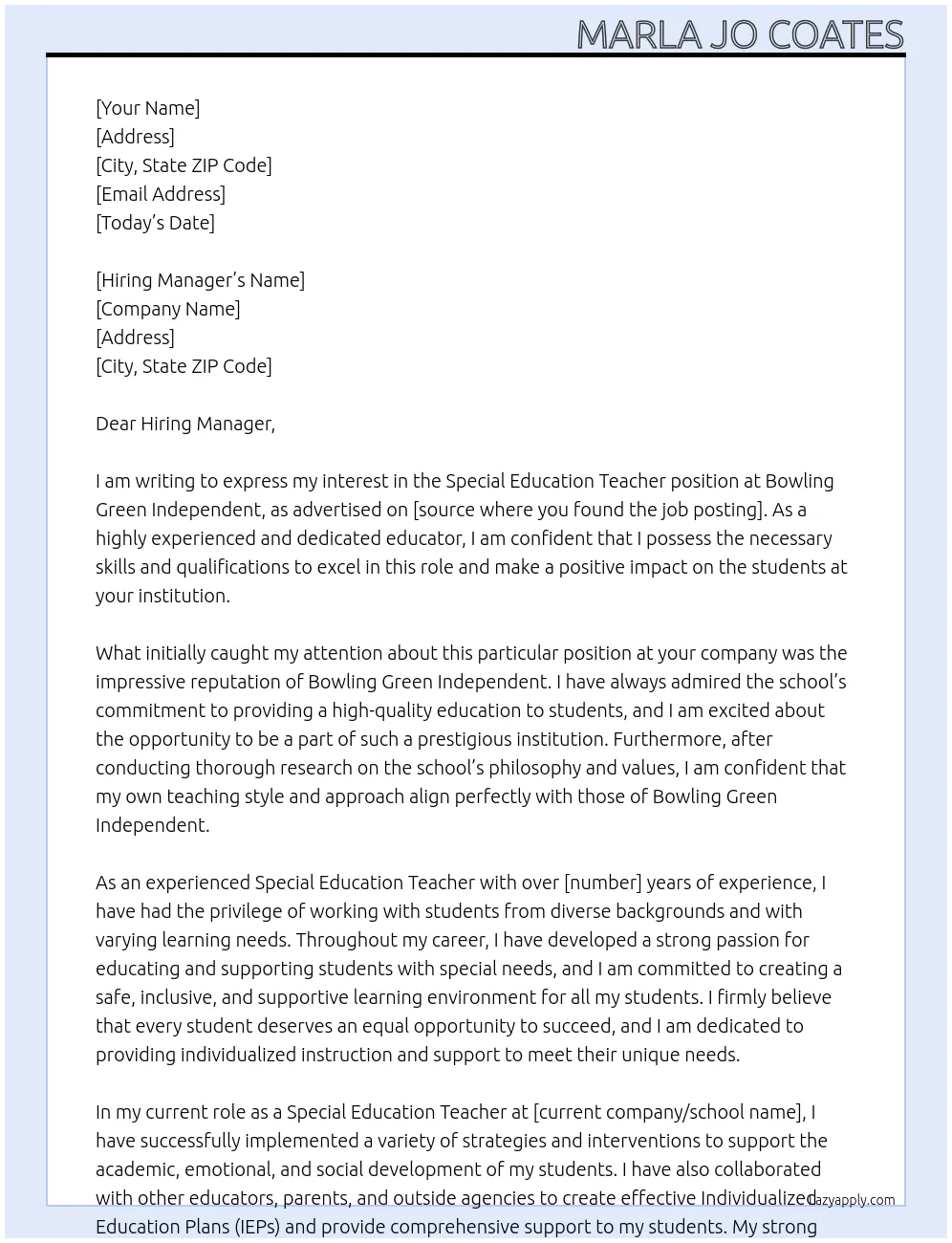
When detailing your skills, be as specific as possible. Instead of simply stating you have ’experience with students with autism,’ describe specific strategies you’ve used, such as visual supports, structured teaching, or social stories. If you’re proficient in a particular assistive technology, mention the name of the software or device and how you’ve used it to support student learning. Detail any experience with specific disabilities or conditions, like ADHD, dyslexia, or emotional disturbances. If you’re fluent in a language other than English, be sure to mention it, as this can be a valuable asset in diverse school environments. The more detailed and relevant you are, the better. Remember that demonstrating your skill is superior to simply claiming to have them.
Experience and Achievements
Your cover letter should provide concrete evidence of your accomplishments as a special education teacher. Focus on highlighting your key achievements and the positive impact you’ve made on students’ lives. Don’t just list your job responsibilities; instead, describe specific projects you’ve led, initiatives you’ve implemented, and positive outcomes you’ve achieved. For example, did you develop a new reading program that significantly improved student literacy rates? Did you create a supportive classroom environment that reduced behavioral incidents? Did you successfully advocate for a student’s needs, leading to improved support and progress? Be sure to tailor your examples to align with the school’s mission and values. This will demonstrate not only your skills, but also your ability to deliver on your promises.
Quantifying Your Impact
Whenever possible, quantify your achievements with data and statistics. Instead of saying you ‘improved student test scores,’ state that you ‘increased reading comprehension scores by 20%.’ If you implemented a new behavior management system, mention the percentage decrease in behavioral incidents. If you facilitated a successful IEP meeting, indicate how many stakeholders participated and the positive outcomes achieved. Using numbers makes your accomplishments more tangible and persuasive, demonstrating your ability to drive positive change. Metrics can also help the hiring manager immediately understand your value. Moreover, it lends credibility to your claims, establishing you as a results-driven professional. Where applicable, use percentages, specific numbers, and concrete measurements to showcase the effectiveness of your work.
Tailoring Your Cover Letter to the School
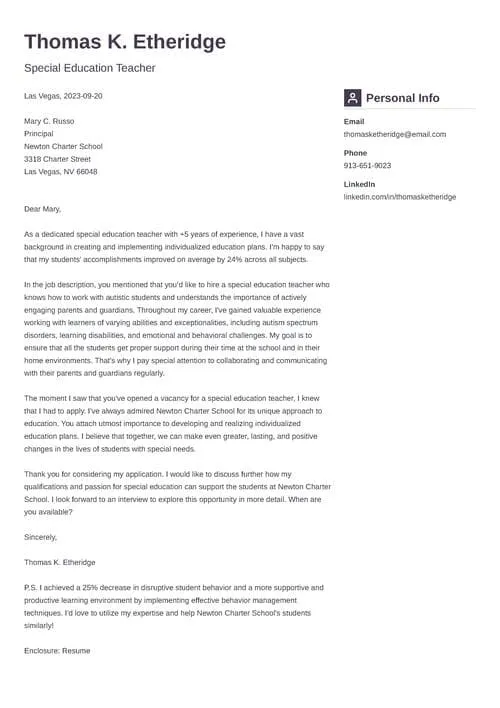
A generic cover letter that’s sent to every school won’t make a strong impression. It is crucial to customize each cover letter to the specific school and position for which you’re applying. This demonstrates your genuine interest in the school and your understanding of their specific needs. Research the school’s mission statement, values, and programs to gain insight into their priorities. Carefully read the job description, noting the key qualifications, responsibilities, and desired skills. Use this information to tailor your cover letter, emphasizing how your skills and experience align with their specific requirements. If the school has a particular focus on inclusion, for example, highlight your experience with inclusive practices and your commitment to creating a welcoming environment for all students. Tailoring shows you’re serious.
Researching the School’s Needs
Before you even begin writing, dedicate time to researching the school. Visit their website, explore their social media profiles, and, if possible, read any recent news articles or publications about the school. Look for information about their special education programs, their approach to student support, and any specific initiatives they are pursuing. If you know anyone who works at the school, reach out to them for insights. The more you know about the school, the better you’ll be able to tailor your cover letter and demonstrate how your skills and experience align with their specific needs. Demonstrate you have an understanding of the school culture and community, showing you’ve done your homework and are genuinely interested in the opportunity.
Addressing Specific Requirements
Carefully review the job description and identify any specific requirements the school has listed. Does the position require experience with a particular disability, teaching methodology, or assistive technology? Does the school prioritize collaboration with parents or staff? Address these specific requirements directly in your cover letter. Use keywords and phrases from the job description to demonstrate that you’ve read it and understand the school’s needs. Explain how your skills and experience align with each requirement, providing specific examples to support your claims. This shows that you’re not only qualified, but also a good fit for the position. Take each item listed on the job description and explain your experience with it.
Formatting and Structure
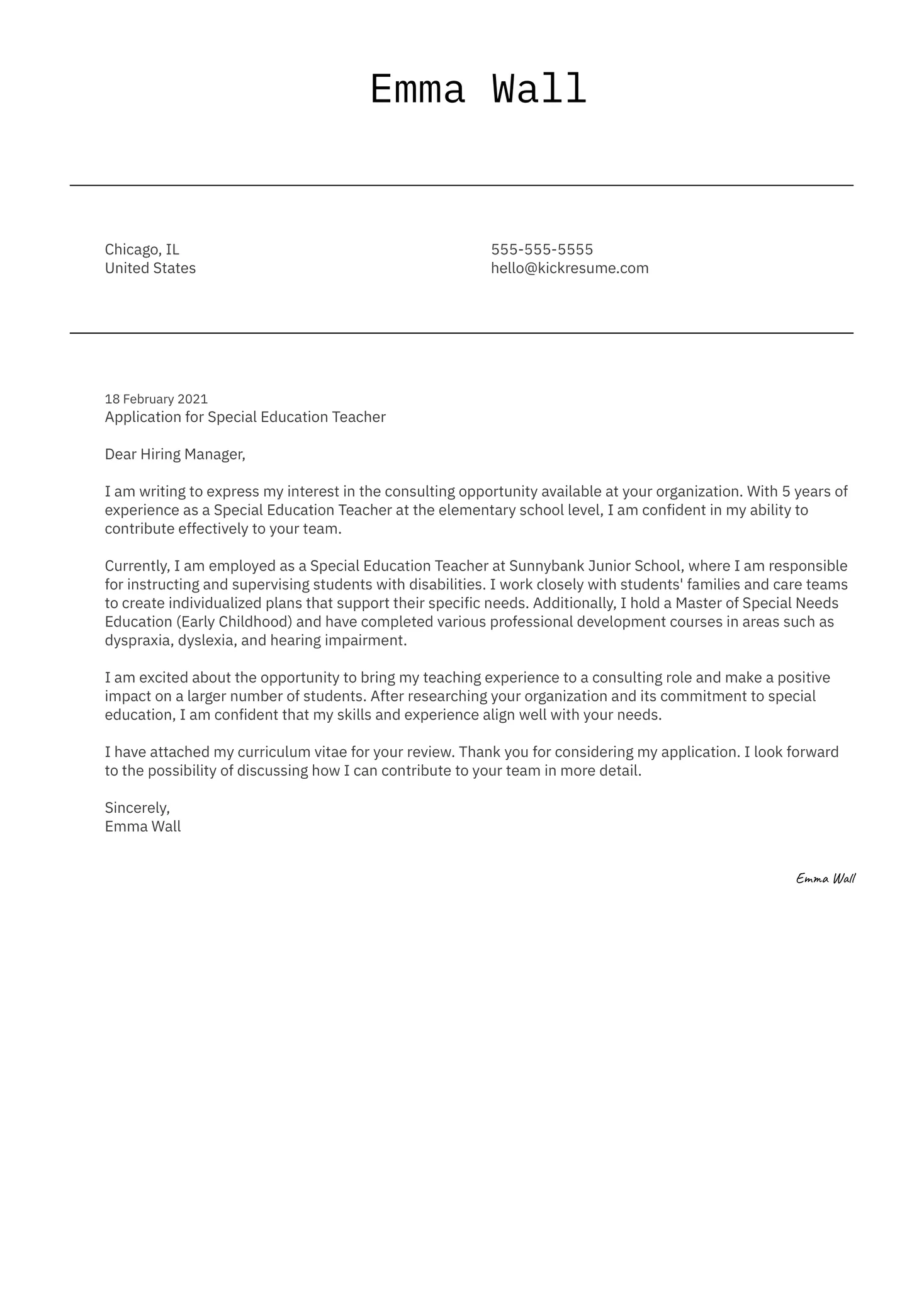
The format and structure of your cover letter are just as important as its content. A well-organized and visually appealing cover letter is easier to read and makes a positive impression. Use a professional and readable font, such as Times New Roman, Arial, or Calibri, and ensure your font size is easy on the eyes (11 or 12 points). Use clear headings and subheadings to break up the text and guide the reader. Keep your paragraphs concise and focused. Proofread your cover letter carefully for any grammatical errors or typos, as these can damage your credibility. Aim for a professional and polished look, reflecting your attention to detail and commitment to excellence. Use formatting to draw attention to important information.
Key Elements of a Cover Letter
A strong cover letter should include several key elements. Begin with a professional header that includes your contact information and the date. Address the hiring manager by name, if possible; this demonstrates that you’ve done your research. In the opening paragraph, state the position you’re applying for and how you learned about it. Briefly introduce yourself and express your enthusiasm for the opportunity. In the body of your cover letter, highlight your relevant skills, experience, and accomplishments. Tailor your content to the specific school and position, emphasizing how your qualifications align with their needs. Close with a strong call to action, expressing your interest in an interview and thanking the hiring manager for their time and consideration. Use the following as a guideline.
- Your Contact Information
- Date
- Hiring Manager’s Name and Title
- School’s Name
- Address
- Salutation (Dear Mr./Ms./Mx. Last Name)
- Opening Paragraph
- Body Paragraphs (Highlight Skills, Experience, and Accomplishments)
- Closing Paragraph (Call to Action)
- Complimentary Close (Sincerely, Regards, etc.)
- Your Typed Name
- Your Signature (if submitting a hard copy)
Using Action Verbs
Action verbs can significantly enhance the impact of your cover letter. They make your descriptions more dynamic and engaging, providing a sense of energy and achievement. Instead of using passive language, use strong action verbs to highlight your accomplishments and responsibilities. For example, instead of writing ‘Responsible for developing IEPs,’ write ‘Developed and implemented individualized education programs (IEPs) for students with diverse needs.’ Consider these action verbs: ‘Developed,’ ‘Implemented,’ ‘Managed,’ ‘Collaborated,’ ‘Created,’ ‘Led,’ ‘Taught,’ ‘Adapted,’ ‘Assessed,’ ‘Evaluated,’ ‘Improved,’ ‘Mentored,’ ‘Motivated,’ ‘Organized,’ ‘Planned,’ ‘Provided,’ ‘Supported,’ and ‘Trained.’ Using action verbs paints a vivid picture of your skills and experience, conveying your ability to take initiative, achieve results, and make a positive impact.
Proofreading and Editing
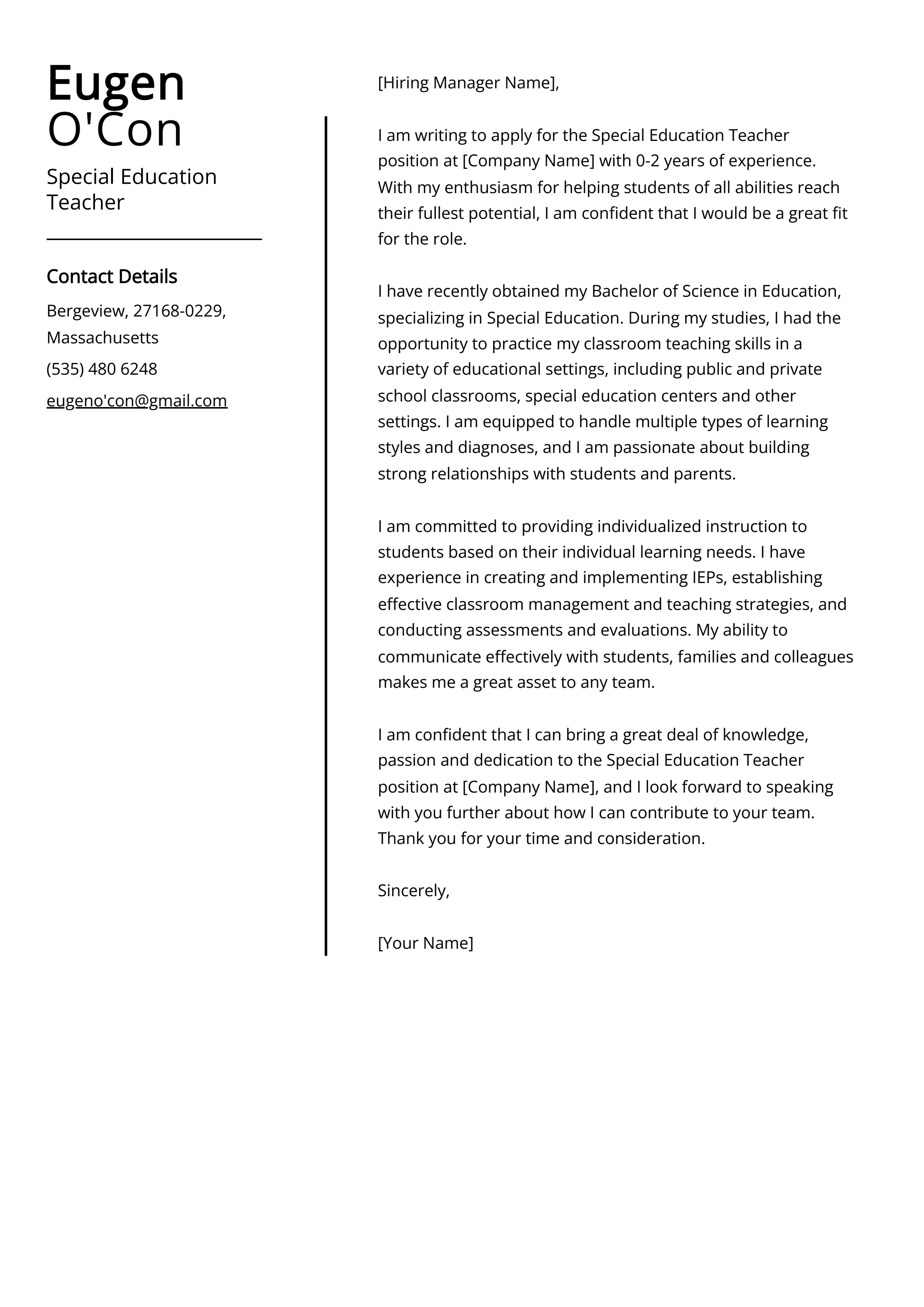
Proofreading and editing are crucial steps in ensuring your cover letter is polished and professional. Before submitting your application, carefully review your cover letter for any grammatical errors, typos, or inconsistencies. Even minor mistakes can undermine your credibility and suggest a lack of attention to detail. Read your cover letter aloud to catch any awkward phrasing or sentence structure. Ask a friend, family member, or career counselor to proofread your cover letter as well. A fresh pair of eyes can often spot errors that you might have missed. Pay close attention to your spelling, grammar, punctuation, and sentence structure. Ensure that your tone is professional, enthusiastic, and aligned with the school’s culture. A flawless cover letter demonstrates your commitment to excellence and your professionalism, significantly increasing your chances of getting hired. Edit and re-edit until it is error-free.
Cover Letter Dos and Don’ts
Creating a successful cover letter means knowing what to do and what to avoid. Following these guidelines will help you create a cover letter that is both compelling and effective.
Common Mistakes to Avoid
Several common mistakes can damage your cover letter and decrease your chances of getting hired. Avoid using generic, mass-produced cover letters; instead, tailor each letter to the specific school and position. Refrain from simply repeating information from your resume; your cover letter should expand on your accomplishments and provide context. Don’t use jargon, slang, or overly casual language; maintain a professional tone throughout your letter. Avoid negative language or complaining about previous employers or experiences. Don’t focus solely on yourself; instead, emphasize how you can contribute to the school’s success. Avoid typos, grammatical errors, and formatting inconsistencies; these can create a negative impression. Lastly, never submit a cover letter without proofreading it thoroughly.
Best Practices for Special Ed Teachers
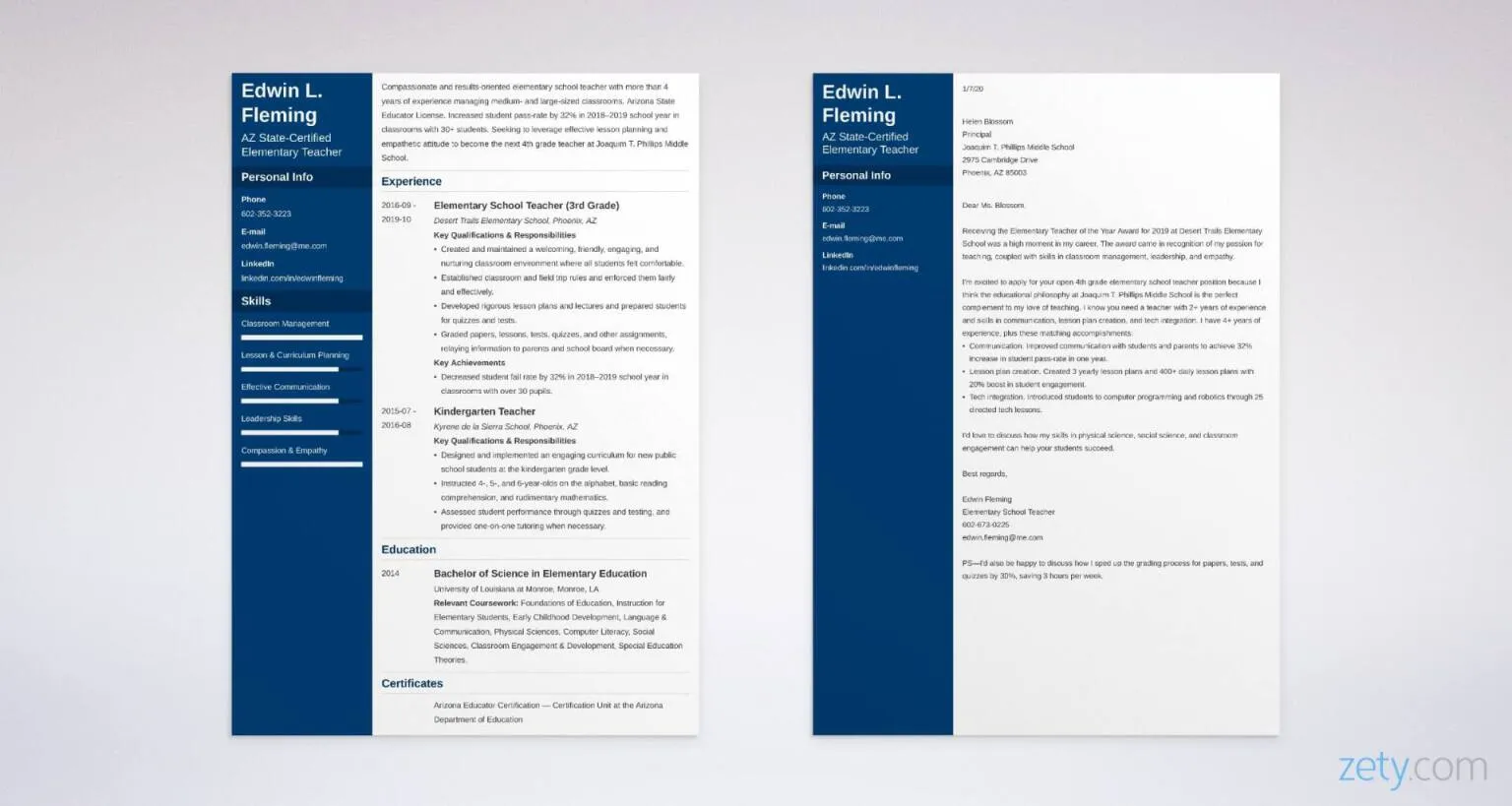
Special education teachers should pay specific attention to several best practices. Highlight your experience with inclusive education and your commitment to creating a welcoming and supportive environment for all students. Demonstrate your ability to differentiate instruction and adapt lesson plans to meet the diverse needs of students with disabilities. Emphasize your experience collaborating with parents, support staff, and other professionals to create a comprehensive support system for students. Showcase your understanding of IEPs and your ability to develop and implement effective IEP goals. Provide specific examples of how you’ve used data to track student progress and adjust instruction accordingly. Always express your passion for special education and your commitment to helping students with disabilities reach their full potential. Show your best qualities to stand out in the crowd.
Call to Action
The final section of your cover letter should include a clear call to action, encouraging the hiring manager to take the next step. Express your interest in an interview and reiterate your enthusiasm for the position and the school. Make it easy for the hiring manager to contact you by including your phone number and email address. Thank the hiring manager for their time and consideration. This shows that you are eager to continue the conversation and are ready to discuss your qualifications in more detail. The goal is to make a lasting impression that moves you forward in the hiring process. By providing a strong close, you increase your likelihood of receiving a call for an interview.
Expressing Your Enthusiasm
Let your passion for special education shine through in your cover letter. Express your enthusiasm for the opportunity to work with students with disabilities and make a positive impact on their lives. Share why you are drawn to the school or district and what you admire about their programs or values. Highlight your teaching philosophy and how it aligns with the school’s mission. Show that you are excited about the prospect of contributing to the school community. By expressing your genuine enthusiasm, you’ll make a more memorable impression on the hiring manager. It humanizes the application, making you more than a collection of skills; you become a passionate educator.
Providing Contact Information

Make it easy for the hiring manager to contact you by providing clear and accurate contact information. Include your full name, phone number, and professional email address. Double-check your contact information to ensure it is correct and up-to-date. Consider including a link to your professional online portfolio or LinkedIn profile, if you have one. Ensure that your voicemail greeting is professional and reflects your commitment to education. This shows the hiring manager that you are readily available and eager to discuss the opportunity further. Make it seamless for the hiring manager to reach out to you.
